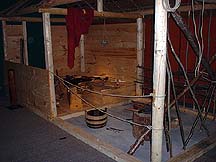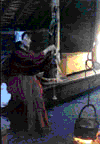

" Most people lived a simple life on farms in large extended family
groups. A 'Bondi' was a 'bound man', a person who had given oaths of allegiance
or had blood ties to a more powerful chieftain.
A simple camp like this one would have been typical for the first days
in Vinland. A spare sail thrown over the oars keeps the rain off a sheepskin
sleeping bag. For most Norse, all you owned would fit into a single sea
chest or on your body. Woman's work would be ceaseless, especially combing,
spinning, and weaving wool into cloth. Food was commonly stews prepared
in a communal pot. Most men were not warriors, a spear was more useful
for hunting than fighting."
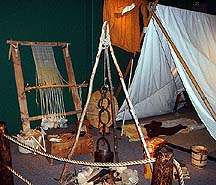
|
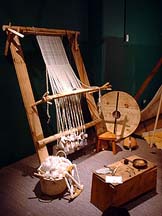 |
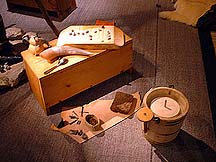
|
|
|
|
|
These objects
are more representative of the common person. Again, most people lived
on large farm steads, grouped with family, servants and even slaves. Compare the number a quality of objects here with those in the Chieftain's Camp. A special focus here is on Vinland. When the Norse first arrived in Northern Newfoundland around 1000 AD, they would have lived in simple tent shelters until the turf houses were completed.
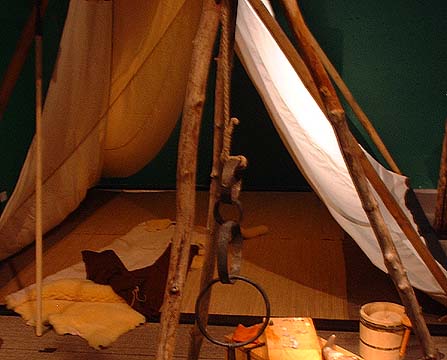
(10) Sail : Once again, only small fragments of original sails
survive. Likely most were made of felted wool, although both leather or
imported linen canvas were possible. This sail cloth (of modern cotton!)
is about 10 x 20 feet overall.
(Conjecture
unbleached cotton / artist : Peter Lefebvre)
Oars : The tent frame here are several of the oars lashed together.
Oars were shaped from single pine or ash poles, resulting in a very small
blade surface. They are made this way for strength. Normally a freight
vessel, or knarr, would only have six or eight ores. Lashings are made
from hemp rope.
(Roskilde, Denmark / Viking Age
pine poles / assisted by Brad Markewitz)
(11) Sheepskin Sleeping Bag: Eight sheepskins are sewn together
with leather laces to produce this bag. It has toggles and loops down one
side so it open could double as a heavy cloak or blanket. With the sail
ten open on the ends and you sleeping on the ground, it would not have
been all that comfortable. Compare with Chieftain's bed.
(Conjecture
sheepskins, leather lace)
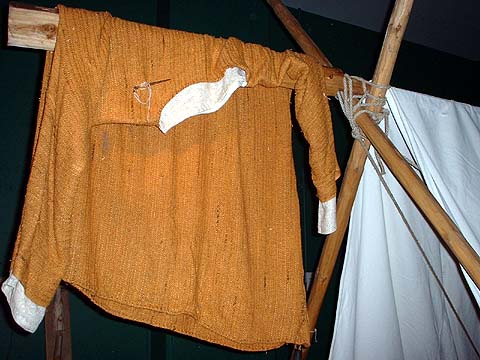
(12) Man's Clothing: Compare with the woman's clothes in Chieftain.
Linen Shirt, wool Tunic : Note how similar the cut is
to the woman's. The simpler colours and rougher texture to the fabric indicate
less wealth is involved.
Pants : Only men wore pants in the Viking Age.
(Conjecture
wool, linen, blends / artist : Vandy Simpson)
Ring Pin: This simple ring headed pin is a reproduction of one
found at L'Anse aux Meadows in Vinland. This artifact find proved the site
was from the Viking Age. It was used to hold a cloak shut, and is style
common to Norse Ireland and Iceland around the year 1000. Link to other
LAM Objects.
(LAM, Canada / 1000
bronze / artist : David Robertson
Artifact in Full Circle)
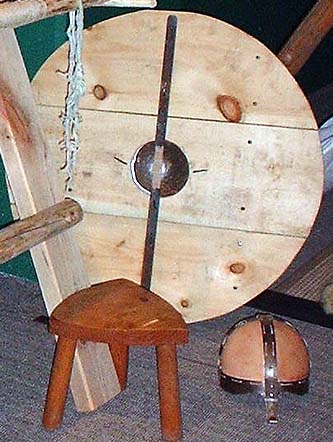
(13) Shield : Described under Chieftain
(Gokstad, Norway / 800
pine, forged steel
Artifact in Full Circle)
Helmet : This simple helmet has plain bands riveted together
with heavy leather plates forming the skull. The top bar extends to form
a nasal to protect the face, Such a helmet would keep a sword from killing
you - once. Compare with the Chieftain's.
(Conjecture
steel, leather plates)
Spear: In comparison with the Chieftain's sword, this spear is
primarily a hunting tool, designed to be thrown.
(Iceland / 920
forged steel, ash
Artifact in Full Circle)
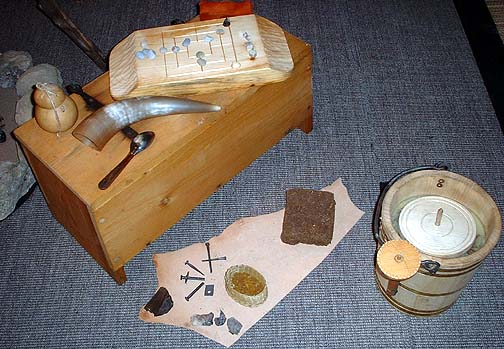
(14) Navigation Tools, both are relative position instruments that work by measuring the sun's shadow.
Latitude Disk,This instrument is speculative, as no samples survive.
It determines your relative position north to south. Suns shadow at mid
day (shortest) is compared to circle measured at known location. By floating
it in the bucket it would remain level when ship board.
(Speculative
pine)
Bearing Dial - calibrated before your trip, it indicates location
of north. Arc of suns shadow is drawn on shore. Later, shadow is measured
to touch arc and north is indicated.
(Greenland / Viking Age
pine / artist : AG. Smith)
Bucket - This bucket, with its brass hoops, is really a bit to
fine for the Bondi. Wooden buckets (large at top), pails (large at bottom),
tubs (straight sides), and barrels are the primary storage for any liquid
up until the modern age.
(Oseberg, Norway
pine, brass, forged steel / artist : Gary Stephens)
(15) Sea Chest : See description under Chieftain
(Oseberg, Norway / 825
pine, forged steel )
Wooden Trencher: This is a simple slab of wood carved to a plate.
On the back is carved a simple game of '9 Man Merrels' with found object
game counters. Compare with Chieftain's game.
(Various / Viking Age
pine / artist : Randy Markewitz
Artifact in Full Circle)
Drinking Horn : One simple solution to a water proof container.
Easily obtained whenever you kill a cow. Bee's wax lined to keep horn taste
out of your drink. Compare with that in Town House, glass 'horn' of Chieftain.
(Non Specific / Viking Age
natural horn, bee's wax)
Gourd Bottle. Another natural container, but this is water resistant
- as opposed to water proof. Compare with other containers in exhibit.
(Conjecture
natural gourd)
(16) A visit to Vinland, objects found at L'Anse aux Meadows:
Ship Rivets : With Roves. Longships are built using the
'lapstrake' method, where individual planks overlap to be held in place
with these rivets (rather than nailed to a frame). When the salt water
corrodes the rivet, it is banged out and a new one is replaced - it was
these failed rivets that were found at LAM. Compare with Nail Header in
Town House Blacksmith and Hull Section.
(LAM, Canada / 1000
forged steel
Artifact in Full Circle)
Bog Iron : This naturally occurring type of iron ore is found
throughout the North. It takes a special geography to create, with a chain
of acidic bog over iron rich rock, then a bubbling brook containing a particular
bacteria. Bog iron also occurs in NE coastal USA, and was used in Colonial
times. This sample from the LAM area.
(LAM, Canada / 1000
natural ore
Artifact in Full Circle)
Smelting Slag : The bog ore is placed in a special flask shaped
furnace called a smelter and heated with charcoal. It takes four to six
hours at extremely high temperatures to convert the ore to metallic iron.
One other result is the creation of a glass like slag, which is allowed
to run out of the bottom of the smelter at the end of the process. This
slag then indicates to the archaeologist that iron was produced - at told
them that LAM had a European origin.
(LAM, Canada / 1000
iron slag / Dark Ages Re-creation Company
Artifact in Full Circle)
Wrought Iron 'Bloom' : The desired result of an iron smelt is
to produce a large mass of wrought iron metal, called a bloom. This is
a fragment of one such smelt. It would then be worked in a separate forge
fire to shape out the required iron bars. Link to Town House Blacksmith.
(see above)
(LAM, Canada / 1000
wrought iron / artist : Lee Sauder)
Turf block: 'Sod Houses' leaves the wrong impression. Walls are
in fact made of turf, which is compressed peat moss. This is cut out in
large slabs, and when dry stacked to create walls some six feet thick.
An excellent insulator. Compare with Town House construction.
(LAM, Canada / 1000
natural peat)

(17) The cooking fire:
Trammel : Of forged chain and hemp rope. The trammel is used
to adjust the height of the pot above the fire, and thus the cooking temperature.
Ornamental forged 'cauldron hangers' were a sign of wealth.
(St Petersburg, Russia / 900's
forged steel, hemp
Artifact in Full Circle)
Tripod : Of simple wooden poles. Contrast with Chieftain
(Conjecture
natural maple saplings)
Cooking Fork : For roasting large pieces of meat. In use a forked
stick would hold up the fork, while a rock anchored the end.
(Sarheim, Norway / 900's
forged steel, ash
Artifact in Full Circle)
Cooking Pot. Here the most common construction of riveted metal
plates. The pot would be sealed from leaking by cooking jam or porridge
(as this one was), and then never cleaning the outside or joints. The normal
supper is the 'endless stew pot', where todays ingredients were added to
yesterdays left overs. Compare with Chieftain's.
(Bengtsarvet, Norway / 1000's
dished steel)

(18) Small Textile Tools:
Sea Chest : See description under Chieftain.
(Oseberg, Norway / 825 pine, leather / artist : Brad Markewitz)
Bone Needles : For sewing. Imagine how hard it is to make a small
needle with a knife, especially to cut the hole!
Naelbinding with Needle: This is a partially completed
sock. This type of single needle knitting is more like modern crochet.
It was used to make socks, mittens and skull caps. It uses short lengths
of yard, and ideal use for pieces left over while weaving.
(needles - Various / Viking Age
natural bone
Artifact in Full Circle
naelbinding York, England / 900's
handspun wool / artist : Vandy Simpson)
Needle Hone: A small stone for sharpening iron needles. A stone
like this was found at LAM, and is typically a woman's object. Link to
LAM Objects.
(Various / Viking Age
natural stone
Artifact in Full Circle)
Shears : This style of shear is ancient. Lager sizes were used
for shearing sheep. Link to Fleece.
(Various / Viking Age
commercial
Artifact in Full Circle)
Spindle : The soapstone weight, or whorl, is like the one found
at LAM. The drop spindle is used to twist wool fibres into thread or yarn.
This small size is used for creating fine sewing thread. Finding the spindle
whorl proved LAM predated explorers like Cabot and Cartier. Link to LAM
Objects, Spinning tools, Loom.
(LAM, Canada / 1000
soapstone, maple / artist : Neil Peterson
Artifact in Full Circle)
Wooden Bowl : An object such as this would be most likely purchased
at a Town. Artisans there would use a 'spring pole lathe' to produce bowls
such as this. Compare with Trencher.
(York, England / 900's
maple (?) / commercial)
Horn Spoon : Cow horn is the plastic of the Viking Age. Made
of a material like your finger nails, it becomes soft when heated. Here
a 'ball on a stick' shape would be boiled, then clamped between two shaped
blocks of wood to create the bowl. Link to Drinking Horn.
(Non Specific
natural horn / commercial)
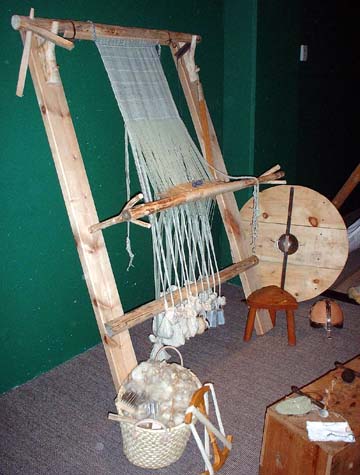
(19) Basket with spinning tools:
Fleece : Is washed and ready to spin. This is 'Icelandic' breed
sheep, even today much like those from the Viking Age. Note the colour,
this 'white' fleece would be dyed using plants or lichens for colour. Link
to Drop Spindle
(Non Specific
natural - Icelandic breed / Glen Osprey Farm)
Wool Combs,: Before spinning, these combs are used for straightening
the fibers (and removing any material like grass).Link to Drop Spindle
(Terum, Norway / Viking Age
maple, steel)
Drop Spindle: Like the soapstone spindle, for twisting wool into
thread. This ceramic weight is larger and heavier, and thus allows a thicker
thread to be twisted.
(Various / Viking Age
ceramic, maple / artist : David Clarke
Artifact in Full Circle)
Wool Winder : Once the spindle is full, the thread is wound off
on to this frame as seen. This pulls the thread straight, the thread would
be left on here before it was transferred to the Shuttles on the Loom.
Link to Loom.
(Oseberg, Norway / 825
pine / artist : David Cox)
(20) Weaving tools:
Loom : This simple upright wooden frame forms a 'Warp Weighted'
loom, the type used in the Viking Age (and also up to modern times in rural
Scandinavia and Iceland).
(Faeroe Islands/ Viking Age
pine poles)
Warp: Runs up and down, and is made of the spun wool thread.
There are about 20 threads to each inch, and the warp is 16 " wide. This
warp is about 72" long . This all means that the warp alone requires about
2000 feet of spun wool. Link to Spinning Tools.
(Conjecture
wool / artist : Vandy Simpson)
Weights Are made of Ceramic, Soapstone and simple
Stones
(in bags). The weights, each about one and a half pounds, are tied to groups
of the warp threads to pull them tight.
(Various / Viking Age
soapstone
Artifact in Full Circle
Hedeby, Germany/ Viking Age ceramic / artist
: David Clarke
Conjecture
stone (in cloth bags) / artist : Vandy Simpson )
Shuttle : Is loaded with more spun thread, and is used to pass
threads through the warp. To produce a fabric with a pattern, several of
different coloured thread would be used.
(Non Specific
oak)
Weaving Sword : Is used to tap the threads tight. Once this is
complete, the front bar (called a heddle) is moved to lift a different
set of threads forward for the next row of thread.
(Various / Viking Age
oak
Artifact in Full Circle)
Cloth : The number of threads across (the weft) is normally the
same as those up and down, so add another 20 threads per inch on this piece
(x 18 x 16). The short piece of cloth, 16" wide and 18" long, uses total
of 960 feet of spun wool. This is perhaps enough to make one arm of a man's
tunic. Imagine the tens of thousands of 'woman hours' required to make
a sail!
(Conjecture
wool, some handspun / artist : Vandy Simpson)
